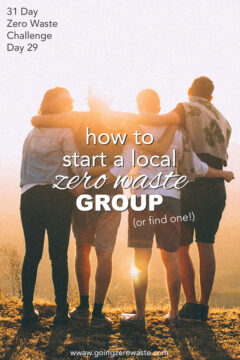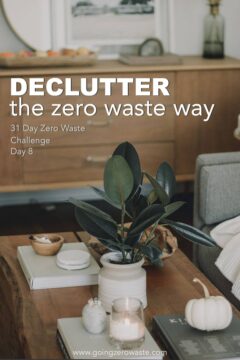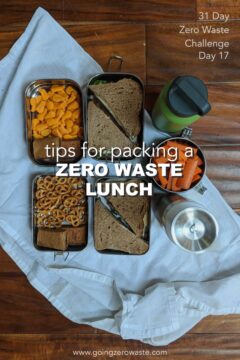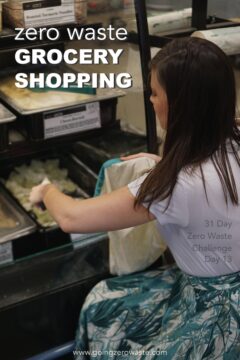Shop Local – Day 28 of the Zero Waste Challenge
31 Day Zero Waste Challenge
January 28, 2019 | Kathryn Kellogg
Last Updated on January 23, 2024
Most of the products available on store shelves are made overseas. When things are made far away from you, they have to travel a long ways to make it onto store shelves. This can incur higher carbon emissions.
It won’t be possible to buy everything local, but today, I challenge you to support your local community and buy locally made products when possible.

It’s day twenty eight of the zero waste challenge! There are only three more days of the challenge left: Congrats for getting this far!
The beginning of the challenge is focused on simple swaps like bringing your own water bottle and bags to the grocery store.
The second phase of the challenge is focused on lifestyle changes like learning to make your own snacks, decluttering your life the zero waste way, and conserving natural resources.
Now, we’re into the third phase of the challenge. The activism phase.
The phase where you get to get a little outside of yourself and work on bringing change at a whole new level.
(I will say a couple of posts are out of order. We had an activism post earlier in the challenge and we’ll have a lifestyle change in this section, but you can forgive me, right!? Thanks 🙂
Today we’re talking about shopping locally.
Prefer video content?
Scroll down to the bottom of the page.
Table of Contents
the problem:
Often times when we buy things, they might come from overseas or really far away maybe it’s clothing rack made in China or tomatoes during winter that came from Mexico.
If you buy summer produce in the dead of winter, it’s most likely coming from the opposite hemisphere, so by living local, we’re buying things that come from our immediate vicinity.
Whenever things are transported from far away, it uses a lot of emissions. By buying things closer, it uses fewer emissions.
This is great for both the environment and supporting local members of your community.
Whenever you’re shopping for food, go for a local farmers market. They’ll have the freshest, locally grown produce around, all package free.
If you’re shopping for things, like soap, candles or handmade goods, there are typically a lot of people in your community who are really crafty you can purchase from and support.
I recommend doing a quick search online to see what’s available near you.
If you’re searching for handmade soap, for example, type that into the search bar, then your city (ex: handmade soap in your city). You might be surprised at what pops up.
You can also try Etsy and find makers who live close to your vicinity.
At the very least, you’ll know the product is handcrafted with love and care, and your purchase will help support a small business.
I encourage you to also go to local flea markets and see what stands pop up – a lot of great local businesses don’t always have the strongest online presence.
You can also walk around your town and see what you come across (mom and pop businesses are always great to support, if you find one).
Shopping local is just this really beautiful system: You’re supporting a member of your community and when they pay their taxes, the tax dollars go back into the community.
This only helps improve your community even further.
I also notice a lot of these mom and pop shops are very accommodating when it comes to bringing your own containers.
There’s a fabulous shop in my town downtown that sells things like soap, incense and bath teas, and the shop owner sells shea butter and cocoa – two things you will see commonly in my DIY recipes.
The shop owner sells them in plastic tubs. But I can give her a call and come over and she will put them in my mason jar!
It’s just so nice to be able to make that connection and having those face to face interactions rather than going through a cooperation.
Here are a few ways to live as local as possible:
-
Shop for fresh produce at your local farmers market.
-
Ask your local farmers what’s in season for your region.
-
Find mom and pop shops that you can support.
-
Locate a small coffee shop that’s unique to your vicinity to frequent.
-
Attend local flea markets, fairs, conventions and festivals to meet your local makers.
-
Do a quick online search for homemade goods in your area.
-
Take a visit to your local farm, if your state has one.
-
Know someone who’s crafty? Pay them to make you something only they could create.
-
Support your local thrift store.
-
Go and support your local library, makers space and community center.
-
Go to your local deli and get cheese and bread package free in your own containers.
-
Support your local butcher and get your meat in glassware.
-
Find a local florist who sells plastic free flowers grown without pesticides.
-
Locate a bulk food shop near you and bring your own containers.
There are so many ways to support your local community, but these are just a few.
You don’t always have to purchase something in order to support your community either.
Simply picking up litter, joining a community garden, or participating in a local group that shares your ethics can help your town ton loads.
So, my challenge for you today is to live local.
take the challenge!
Over the next 3 days, your challenge is to live local.
Instead of supporting brands and businesses that are overseas, shop local.
This means finding your local farmers market, homemade goods, mom and pop shops, and getting involved in your community.
When you support smaller businesses you are driving money back into your community and reducing emissions at the same time.
Will you be taking the challenge?
want more?
Just starting out? Have 1,000 burning questions!?
Get access to my private Facebook group, where I’ll be hosting weekly lives throughout the challenge and I answer all of your most pressing questions.
PLUS! I’ll be sending out a brand new e-book at the end of the challenge called the Game On Handbook which is all about individual ways to fight climate change.
You don’t want to miss it.













